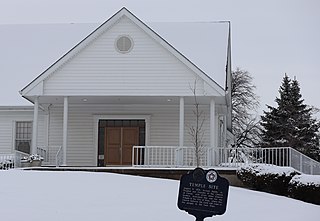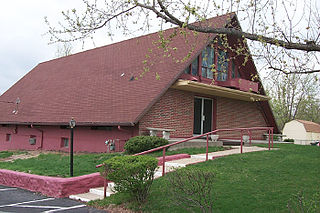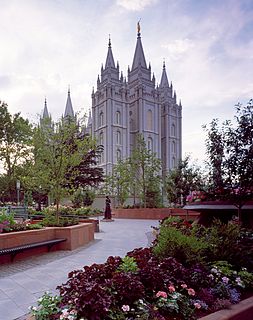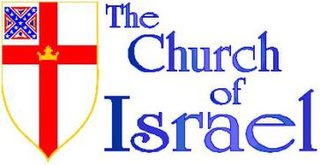Related Research Articles

The Church of Christ, informally called Hedrickites and the Church of Christ , is a denomination of the Latter Day Saint movement headquartered in Independence, Missouri, on what is known as the Temple Lot. The nickname for members of the church comes from the surname of Granville Hedrick, who was ordained as the church's leader in July 1863. Unlike The Church of Jesus Christ of Latter-day Saints and Community of Christ, the Temple Lot church rejects the office of prophet or president, being instead led by its Quorum of Twelve Apostles. The church also rejects the doctrines of baptism for the dead and celestial marriage promulgated by the Utah-based LDS Church, as well as the Doctrine and Covenants and Pearl of Great Price. While once avidly engaged in dialogue with other Latter Day Saint factions, the church no longer has any official contact with any other organization. It is notable for its sole ownership of the Temple Lot, which it has held for nearly 150 years. As of 2013, membership is 7,310 members in 11 countries. Most of the members live in the United States, but there are parishes in Canada, Mexico, Honduras, Nigeria, Kenya, Democratic Republic of the Congo, Malawi, Tanzania, India, and the Philippines.
Church of Christ may refer to:

The Church of Christ with the Elijah Message is the name of three related church groups and a denomination of the Latter Day Saint movement, headquartered in Independence, Missouri. It split from the Church of Christ in 1943 in a dispute over claimed revelations given to its founder William A. Draves. Draves, an elder in the Fettingite group, claimed to be receiving messages from an angelic being who identified himself as John the Baptist—the same person who had allegedly appeared to Fettingite founder Otto Fetting, a former apostle of the Temple Lot Church of Christ. While many Fettingites accepted these new missives, some did not, leading Draves to form his own church. His adherents claim it to be the sole legitimate continuation of Fetting's organization, as well as that of the Temple Lot church. As of 1987, the church had approximately 12,500 adherents spread between Africa, Europe, Asia, Australia and the Americas.

The Latter Day Saint movement is a religious movement within Christianity that arose during the Second Great Awakening in the early 19th century and that led to the set of doctrines, practices, and cultures called Mormonism, and to the existence of numerous Latter Day Saint churches. Its history is characterized by intense controversy and persecution in reaction to some of the movement's doctrines and practices and their relationship to mainstream Christianity. The purpose of this article is to give an overview of the different groups, beliefs, and denominations that began with the influence of Joseph Smith.

The Churches of God movement is composed of a number of sabbath-keeping churches, among which the General Conference of the Church of God, or simply CoG7, is the best-known organization. Like the Seventh Day Baptists and the Seventh-day Adventist Church, the Churches of God observe Sabbath, the seventh day of the week (Saturday).

Otto Fetting was an American realtor and editor from Port Huron, Michigan who served first as a pastor and evangelist in the Reorganized Church of Jesus Christ of Latter Day Saints, and then later as an apostle in the Church of Christ, commonly referred to as the "Hedrickites". Fetting claimed to have been visited by John the Baptist thirty or more times between February 4, 1927 and his death on January 30, 1933. Fetting was reportedly given instruction concerning the doctrine and practices of Hedrickites and other factions of Christianity, together with directives to begin construction of a temple on the Temple Lot, including its exact dimensions.

In the Latter Day Saint movement, a temple is a building dedicated to be a house of God and is reserved for special forms of worship. A temple differs from a church meetinghouse, which is used for weekly worship services. Temples have been a significant part of the Latter Day Saint movement since early in its inception. Today, temples are operated by several Latter Day Saint denominations. The most prolific builder of temples of the Latter Day Saint movement is The Church of Jesus Christ of Latter-day Saints. There are 168 dedicated temples, 35 under construction, and 48 announced, for a total of 251. Several others within the movement have built, or attempted to build, temples. The Community of Christ operates two temples in the United States, which are open to the public and are used for worship services, performances, and religious education. Other denominations with temples are the Apostolic United Brethren, the Church of Christ, the Fundamentalist Church of Jesus Christ of Latter-Day Saints and the Righteous Branch of the Church of Jesus Christ of Latter-day Saints.

The history of Community of Christ, formerly known as the Reorganized Church of Jesus Christ of Latter Day Saints, covers a period of approximately 200 years. The church's early history traces to the "grove experience" of Joseph Smith, who prayed in the woods near his home in Palmyra, New York, in the early-19th century. Several accounts of this experience have surfaced over the years. Most of the accounts share a common narrative indicating that when he went to the woods to pray, he experienced a period of encountering evil or despair, but then experienced an epiphany or vision in which he came to know and understand God's goodness. Later, as an adult, Smith founded the Church of Christ on April 6, 1830.
Granville Hedrick was a leader in the Latter Day Saint movement after the 1844 succession crisis. In 1863, Hedrick became the founding leader of the Church of Christ, which is one of many churches that claim to be a continuation of the Church of Christ founded by Joseph Smith in 1830.
Francis Gladden Bishop was a minor leader in the Latter Day Saint movement after the 1844 succession crisis. Bishop claimed to be the rightful successor to Joseph Smith; from the 1850s until his death, Bishop led a succession of small groups of Latter Day Saints and converts. His followings have been identified informally by later writers as the Gladdenites and the Church of Jesus Christ of Latter Day Saints (Gladdenite), though the name of a late following is formally The Church of Jesus Christ of the New Jerusalem. In the 1850s, many of Bishop's followers abandoned him and joined the movement that would later become the Church of Christ.

Charles Blancher Thompson was an American leader of a schismatic sect in the Latter Day Saint movement from 1848 to 1858. He claimed the title Baneemy and his followers were known as "Baneemyites".

The Temple Lot, located in Independence, Jackson County, Missouri, is the first site to be dedicated for the construction of a temple in the Latter Day Saint movement. The area was dedicated on August 3, 1831, by the movement's founder, Joseph Smith Jr., and purchased on December 19, 1831, by his colleague Edward Partridge to be the center of the New Jerusalem or "City of Zion" after he received a revelation stating that it would be the gathering spot of the Latter Day Saints during the last days.

The Church of Israel is a denomination that emerged from the Church of Christ in the Latter Day Saint movement.

The Temple Lot Case was a United States legal case in the 1890s which addressed legal ownership of the Temple Lot, a significant parcel of land in the Latter Day Saint movement. In the case, the Reorganized Church of Jesus Christ of Latter Day Saints claimed legal title of the land and asked the court to order the Church of Christ to cease its occupation of the property. The RLDS Church won the case at trial, but the decision was reversed on appeal.
The Word of the Lord refers to one of two books of scripture used by certain factions of the Latter Day Saint movement. The first book, simply entitled The Word of the Lord, is used by members of the Church of Christ (Fettingite), the Church of Christ at Halley's Bluff and the Church of Christ (Restored). The second, called The Word of the Lord Brought to Mankind by an Angel, is accepted only by the Church of Christ with the Elijah Message, and churches derived from it, such as the Church of Christ. Both books contain revelations allegedly given to former Church of Christ Apostle Otto Fetting by an angelic being who claimed to be John the Baptist. The latter title also contains revelations purportedly given to William A. Draves by this same being, after Fetting's death.

The Church of Christ, informally referred to as the Fettingites, is a denomination within the Latter Day Saint movement which split from the Church of Christ—informally known as "Hedrickites"— in late 1929. The faction was formally established on April 8, 1930, and an Associated Press report published in The New York Times and Los Angeles Times April 7, 1930, describes it as having been briefly named "The Church of Jesus Christ" and later, the "Church of Christ". It is informally referred to as the "Church of Christ (Fettingite)", after its founder, Otto Fetting, but this sect has never officially been named as such. Otto Fetting, an Apostle in the Church of Christ, was the alleged recipient of a series of messages delivered by John the Baptist concerning construction of a temple on the Temple Lot, along with other aspects of Hedrickite doctrine and practice. The rejection of his "Twelfth Message" by a majority vote of his fellow Apostles in October 1929 led to a split in the Temple Lot organization between those who rejected Fetting's messages and those who accepted them. The "Fettingites" subsequently established their own church organization.

The Church of Christ (Restored) is a denomination within the Latter Day Saint movement that split from the Church of Christ (Fettingite) in the late 1930s under the leadership of Elder A. C. DeWolf. This schism was provoked by a difference in opinion regarding a series of claimed "messages" received by William Draves, an elder in that church, following the death of founder Otto Fetting. Whereas the main Fettingite church initially chose to grant cautious acceptance to these missives, several Fettingite branches in Louisiana and Mississippi did not, and split from the main organization to form the Church of Christ (Restored). Even after the main Fettingite church chose to reject Draves and his messages in 1943, the DeWolf faction refused to reconcile with the main body, considering itself to be the sole legitimate continuation of the Fettingite church, and the only true church on earth today. Its membership is currently concentrated mostly in the American South, and stands at about 450 members.

The Church of Christ with the Elijah Message - The Assured Way of the Lord, Inc., informally called The Assured Way, is a denomination of the Latter Day Saint movement based in Independence, Missouri. The Assured Way church is one of four groups that trace their origin to the church founded by William Draves in 1943, after his split with Otto Fetting, who had founded the Church of Christ. Although all four churches have similar names and nearly identical doctrines, they are not in communion and maintain separate legal organizations. The Assured Way church was legally incorporated by William Draves' son, Leonard Draves in 2004, six months after Leonard was removed from the ministry by other leaders of the Church of Christ with the Elijah Message, Inc. Leonard Draves had previously founded the Church of Christ with the Elijah Message, Inc., after breaking with the Church of Christ with the Elijah Message, Established Anew 1929.
References
- ↑ Death Certificate for Elmer E. Long "Retired Minister, LDS"
- ↑ Lambertson, Giles (3 June 1976), "11 Arrested at Church After a Take-Over Try", The Nevada Daily Mail, Rust Communications, 92 (252), pp. 1–2, retrieved 16 August 2012